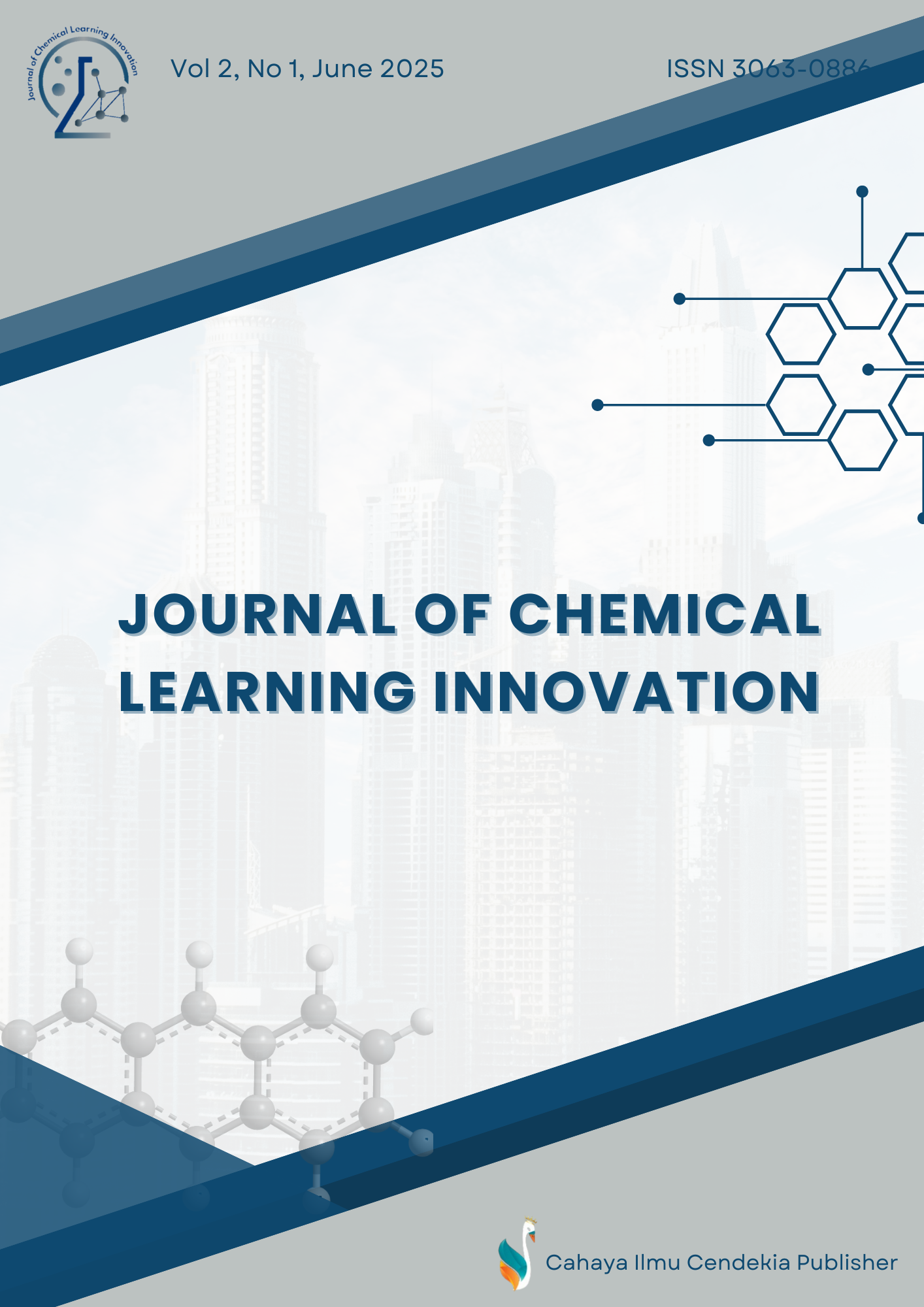Atomic Absorption Spectrophotometry-Based Evaluation of Iron and Chromium in Community Water Sources
Abstract
Purpose of the study: To determine the presence of heavy metal content, especially iron (Fe) and chromium (Cr) in artesian water wells and residents in Rejo Sari Village..
Methodology: In determining pH, pH meter and universal indicator paper were used. The pH values obtained were 6.5; 6.4; 5.9; 7.4; 6.5 and 7.5. Determination of iron (Fe) and chromium (Cr) content was carried out using the Atomic Absorption Spectrophotometry (AAS) method.
Main Findings: The results of the study showed that the concentrations of iron (Fe) were 1.9615 ppm, 0.4692 ppm, 0.4692 ppm, 0.4461 ppm, 1.5615 ppm, and 0.2769 ppm, respectively. One sample with chromium (Cr) concentration was detected at 0.06 ppm.
Novelty/Originality of this study: This study presents a novel contribution by comparing the heavy metals Fe and Cr content in two types of well water sources—artesian wells and ring wells—specifically in a densely populated residential area, using an AAS-based quantitative analysis approach rarely applied simultaneously to both metals in a local context. This study also emphasizes the significance of spatial and environmental quality on heavy metal contamination, which has not been widely addressed in similar studies in the region.
References
M. Singh and S. Ahmed, “IoT based smart water management systems: A systematic review,” Mater. Today Proc., vol. 46, pp. 5211–5218, 2021, doi: 10.1016/j.matpr.2020.08.588.
M. R. Amonovich, N. S. A. O‘g‘li, and S. I. H. Qizi, “Importance of water for living organisms and national economy , physical and chemical methods of wastewater,” Am. J. Res. Humanit. Soc. Sci., vol. 9, no. February, pp. 7–13, 2023.
A. Zafeirakou, A. Karavi, A. Katsoulea, A. Zorpas, and I. Papamichael, “Water resources management in the framework of the circular economy for touristic areas in the Mediterranean: case study of Sifnos Island in Greece,” Euro-Mediterranean J. Environ. Integr., vol. 7, no. 3, pp. 347–360, Sep. 2022, doi: 10.1007/s41207-022-00319-1.
E. K. Kanda, E. Lusweti, and K. O. Odhiambo, “Water–energy–food nexus in Kenya: A review of policy interventions,” World Water Policy, vol. 9, no. 4, pp. 823–836, Nov. 2023, doi: 10.1002/wwp2.12147.
K. K. Agrawal, C. Panda, and M. K. Bhuyan, “Impact of Urbanization on Water Quality,” 2021, pp. 665–673. doi: 10.1007/978-981-33-4795-3_60.
R. Appiah, L. Zhou, E. B. Boadi, T. K. Nsiah, and E. C. Ayamba, “The Causal Link Between Anthropogenic Activities , Water Pollution and Health- Related Quality of Life from Residents ’ Perspective : A Review,” Ijsrst, vol. 1, no. May, pp. 1–17, 2023, doi: 10.32628/IJSRST52310242.
R. O. Oruko et al., “Investigating the chromium status, heavy metal contamination, and ecological risk assessment via tannery waste disposal in sub-Saharan Africa (Kenya and South Africa),” Environ. Sci. Pollut. Res., vol. 28, no. 31, pp. 42135–42149, Aug. 2021, doi: 10.1007/s11356-021-13703-1.
A. Daripa, L. C. Malav, D. K. Yadav, and S. Chattaraj, “Metal contamination in water resources due to various anthropogenic activities,” in Metals in Water, Elsevier, 2023, pp. 111–127. doi: 10.1016/B978-0-323-95919-3.00022-7.
D. N. Perera et al., “Factors affecting iron absorption and the role of fortification in enhancing iron levels,” Nutr. Bull., vol. 48, no. 4, pp. 442–457, Dec. 2023, doi: 10.1111/nbu.12643.
A. Duda-Chodak and T. Tarko, “Possible Side Effects of Polyphenols and Their Interactions with Medicines,” Molecules, vol. 28, no. 6, p. 2536, Mar. 2023, doi: 10.3390/molecules28062536.
P. Sharma, S. P. Singh, S. K. Parakh, and Y. W. Tong, “Health hazards of hexavalent chromium (Cr (VI)) and its microbial reduction,” Bioengineered, vol. 13, no. 3, pp. 4923–4938, Mar. 2022, doi: 10.1080/21655979.2022.2037273.
M.-N. Georgaki et al., “Chromium in Water and Carcinogenic Human Health Risk,” Environments, vol. 10, no. 2, p. 33, Feb. 2023, doi: 10.3390/environments10020033.
Indrastuti, S. Kazama, and S. Takizawa, “Evaluation of Microbial Contamination of Groundwater under Different Topographic Conditions and Household Water Treatment Systems in Special Region of Yogyakarta Province, Indonesia,” Water, vol. 13, no. 12, p. 1673, Jun. 2021, doi: 10.3390/w13121673.
C. C. Amos, I. Lyne, and A. Rahman, “Harvested Rainwater as a Solution for Marine Pollution and Contaminated Groundwater,” 2021, pp. 1–12. doi: 10.1007/978-3-319-71064-8_143-1.
K. S. Gemail and I. Abd-Elaty, “Unveiling the Hidden Depths: A Review for Understanding and Managing Groundwater Contamination in Arid Regions,” 2023, pp. 3–35. doi: 10.1007/698_2023_1049.
D. A.S. and J. V.S., Ground Water Abstraction Structures. in SpringerBriefs in Water Science and Technology. Cham: Springer Nature Switzerland, 2023. doi: 10.1007/978-3-031-34881-5.
S. Viaroli et al., “Limits, challenges, and opportunities of sampling groundwater wells with plastic casings for microplastic investigations,” Sci. Total Environ., vol. 946, p. 174259, Oct. 2024, doi: 10.1016/j.scitotenv.2024.174259.
N. S. A. Kassim, S. A. I. S. M. Ghazali, F. Liyana Bohari, and N. A. Z. Abidin, “Assessment of heavy metals in wastewater plant effluent and lake water by using atomic absorption spectrophotometry,” Mater. Today Proc., vol. 66, pp. 3961–3964, 2022, doi: 10.1016/j.matpr.2022.04.671.
P. Punia, M. K. Bharti, R. Dhar, P. Thakur, and A. Thakur, “Recent Advances in Detection and Removal of Heavy Metals from Contaminated Water,” ChemBioEng Rev., vol. 9, no. 4, pp. 351–369, Aug. 2022, doi: 10.1002/cben.202100053.
M. G. Idris, D. Umaru, A. N. Aliyu, and I. H. Musa, “Atomic Absorption Spectroscopy Analysis of Heavy metals in Water at Daura Gypsum Mining Site, Yobe State, Nigeria,” J. Found. Appl. Phys., vol. 8, no. 2, pp. 227–234, 2021.
B. Fu et al., “Recent progress on laser absorption spectroscopy for determination of gaseous chemical species,” Appl. Spectrosc. Rev., vol. 57, no. 2, pp. 112–152, Feb. 2022, doi: 10.1080/05704928.2020.1857258.
J. Merten, “Laser-ablation absorption spectroscopy: Reviewing an uncommon hyphenation,” Spectrochim. Acta Part B At. Spectrosc., vol. 189, p. 106358, Mar. 2022, doi: 10.1016/j.sab.2022.106358.
A. Aggarwal, T. Verma, and S. Ghosh, “Heavy Metal Residues in Milk and Milk Products and Their Detection Method,” in Trends and Innovations in Food Science, IntechOpen, 2022. doi: 10.5772/intechopen.105004.
D. Krüger, J. T. P. Matshwele, M. D. Mukhtar, and D. Baecker, “Insights into the Versatility of Using Atomic Absorption Spectrometry in Antibacterial Research,” Molecules, vol. 29, no. 13, p. 3120, Jun. 2024, doi: 10.3390/molecules29133120.
M. Mawardi et al., “Article Determination of Cation Exchange Capacity of Napa Soil in 50 Kota Regency using Atomic Absorption Spectrophotometer,” Eksakta Berk. Ilm. Bid. MIPA, vol. 23, no. 02, pp. 64–77, 2022.
M. Mohzana, H. Murcahyanto, M. Fahrurrozi, and Y. N. Supriadi, “Optimization of Management of Laboratory Facilities in the Process of Learning Science at High School,” J. Penelit. Pendidik. IPA, vol. 9, no. 10, pp. 8226–8234, Oct. 2023, doi: 10.29303/jppipa.v9i10.5249.
V. Balaram and S. S. Sawant, “Indicator Minerals, Pathfinder Elements, and Portable Analytical Instruments in Mineral Exploration Studies,” Minerals, vol. 12, no. 4, p. 394, Mar. 2022, doi: 10.3390/min12040394.
V. Mokiichuk, O. Samoilichenko, and A. Zaporozhets, “Theory and Practice of Ensuring the Validity in Testing Laboratories,” 2024, pp. 225–244. doi: 10.1007/978-3-031-40718-5_6.
N. Manousi, W. Wojnowski, J. Płotka-Wasylka, and V. Samanidou, “Blue applicability grade index (BAGI) and software: a new tool for the evaluation of method practicality,” Green Chem., vol. 25, no. 19, pp. 7598–7604, 2023, doi: 10.1039/D3GC02347H.
H.-Y. Chen and C. Chen, “Evaluation of Calibration Equations by Using Regression Analysis: An Example of Chemical Analysis,” Sensors, vol. 22, no. 2, p. 447, Jan. 2022, doi: 10.3390/s22020447.
F. Yue, J. Zhang, J. Xu, T. Niu, X. Lü, and M. Liu, “Effects of monosaccharide composition on quantitative analysis of total sugar content by phenol-sulfuric acid method,” Front. Nutr., vol. 9, Aug. 2022, doi: 10.3389/fnut.2022.963318.
P. D. D. Phan, M. A. N. N. M. Anh, and B. H. Hu. Nguyen, “Using Linear Regression Analysis to Predict Energy Consumption,” Jul. 03, 2024. doi: 10.21203/rs.3.rs-4590592/v1.
D. A. A. Baranger, M. C. Finsaas, B. L. Goldstein, C. E. Vize, D. R. Lynam, and T. M. Olino, “Tutorial: Power Analyses for Interaction Effects in Cross-Sectional Regressions,” Adv. Methods Pract. Psychol. Sci., vol. 6, no. 3, Jul. 2023, doi: 10.1177/25152459231187531.
M. Gregorich, S. Strohmaier, D. Dunkler, and G. Heinze, “Regression with Highly Correlated Predictors: Variable Omission Is Not the Solution,” Int. J. Environ. Res. Public Health, vol. 18, no. 8, p. 4259, Apr. 2021, doi: 10.3390/ijerph18084259.
Y. Guo et al., “Effect of Ultrafine Cement (UFC) on the Corrosion Resistance of Cement Soil in Peat Soil Environment,” Materials (Basel)., vol. 16, no. 16, p. 5520, Aug. 2023, doi: 10.3390/ma16165520.
K. M. Jafery, Z. Embong, N. K. Othman, N. Yaakob, M. Shah, and N. Z. N. Hashim, “SEM-EDX and AFM analysis for the surface corrosion morphology structure and roughness on embedded X70 external pipeline in acidic soil (peat) environment,” Mater. Today Proc., vol. 48, pp. 1929–1935, 2022, doi: 10.1016/j.matpr.2021.09.483.
A. S. Olalekan, S. O. Adewoye, S. O. Henry, O. A. Olaniyi, and M. O. Raimi, “Comprehensive Understanding of Hydrogeochemical evaluation of seasonal variability in groundwater quality Dynamics in the Gold Mining Areas of Osun State, Nigeria,” Nov. 13, 2022. doi: 10.1101/2022.11.06.22282015.
M. Mali, M. R. Alfio, G. Balacco, G. Ranieri, V. Specchio, and M. D. Fidelibus, “Mobility of trace elements in a coastal contaminated site under groundwater salinization dynamics,” Sci. Rep., vol. 14, no. 1, pp. 1–24, 2024, doi: 10.1038/s41598-024-75974-1.
D. Wu, Y. Hu, H. Cheng, and X. Ye, “Detection Techniques for Lead Ions in Water: A Review,” Molecules, vol. 28, no. 8, p. 3601, Apr. 2023, doi: 10.3390/molecules28083601.
D. J. Butcher, “Recent advances in graphite furnace atomic absorption spectrometry: a review of fundamentals and applications,” Appl. Spectrosc. Rev., vol. 59, no. 2, pp. 247–275, Feb. 2024, doi: 10.1080/05704928.2023.2192268.
Copyright (c) 2025 Suci Apriani

This work is licensed under a Creative Commons Attribution 4.0 International License.
Authors who publish with this journal agree to the following terms:
- Authors retain copyright and acknowledge that the Journal of Chemical Learning Innovation is the first publisher licensed under a Creative Commons Attribution 4.0 International License.
- Authors are able to enter into separate, additional contractual arrangements for the non-exclusive distribution of the journal's published version of the work (e.g., post it to an institutional repository or publish it in a book), with an acknowledgment of its initial publication in this journal.
- Authors are permitted and encouraged to post their work online (e.g., in institutional repositories or on their website) prior to and during the submission process, as it can lead to productive exchanges and earlier and greater citation of published work.





.png)
.png)










